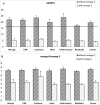A rapid method for determining arachidonic:eicosapentaenoic acid ratios in whole blood lipids: correlation with erythrocyte membrane ratios and validation in a large Italian population of various ages and pathologies
- PMID: 20105293
- PMCID: PMC2834683
- DOI: 10.1186/1476-511X-9-7
A rapid method for determining arachidonic:eicosapentaenoic acid ratios in whole blood lipids: correlation with erythrocyte membrane ratios and validation in a large Italian population of various ages and pathologies
Abstract
Background: Omega-3 and -6 polyunsaturated fatty acids (LCPUFA), are important for good health conditions. They are present in membrane phospholipids.The ratio of total n-6:n-3 LCPUFA and arachidonic acid:eicosapentaenoic acid (AA and EPA), should not exceed 5:1. Increased intake of n-6 and decreased consumption of n-3 has resulted in much higher, ca 10/15:1 ratio in RBC fatty acids with the possible appearance of a pathological "scenario". The determination of RBC phospholipid LCPUFA contents and ratios is the method of choice for assessing fatty acid status but it is labour intensive and time consuming.
Aims of the study: [i] To describe and validate a rapid method, suitable for large scale population studies, for total blood fatty acid assay; [ii] to verify a possible correlation between total n-6:n-3 ratio and AA:EPA ratios in RBC phospholipids and in whole-blood total lipids, [iii] to assess usefulness of these ratio as biomarkers of LCPUFA status.
Methods: 1 Healthy volunteers and patients with various pathologies were recruited.2 Fatty acid analyses by GC of methyl esters from directly derivatized whole blood total lipids and from RBC phospholipids were performed on fasting blood samples from 1432 subjects categorised according to their age, sex and any existing pathologies.AA:EPA ratio and the total n-6:n-3 ratio were determined.
Results: AA:EPA ratio is a more sensitive and reliable index for determining changes in total blood fatty acid and it is correlated with the ratio derived from extracted RBC phospholipids.
Conclusions: The described AA:EPA ratio is a simple, rapid and reliable method for determining n-3 fatty acid status.
Figures




Similar articles
-
Correlation of omega-3 levels in serum phospholipid from 2053 human blood samples with key fatty acid ratios.Nutr J. 2009 Dec 24;8:58. doi: 10.1186/1475-2891-8-58. Nutr J. 2009. PMID: 20034401 Free PMC article.
-
Comparison between the AA/EPA ratio in depressed and non depressed elderly females: omega-3 fatty acid supplementation correlates with improved symptoms but does not change immunological parameters.Nutr J. 2012 Oct 10;11:82. doi: 10.1186/1475-2891-11-82. Nutr J. 2012. PMID: 23046564 Free PMC article. Clinical Trial.
-
Aerobic Physical Activity and a Low Glycemic Diet Reduce the AA/EPA Ratio in Red Blood Cell Membranes of Patients with NAFLD.Nutrients. 2018 Sep 13;10(9):1299. doi: 10.3390/nu10091299. Nutrients. 2018. PMID: 30217048 Free PMC article. Clinical Trial.
-
[Comparison of long-chain polyunsaturated fatty acids in plasma and erythrocyte phospholipids for biological monitoring].Nihon Eiseigaku Zasshi. 2011 Jan;66(1):108-14. doi: 10.1265/jjh.66.108. Nihon Eiseigaku Zasshi. 2011. PMID: 21358141 Japanese.
-
Effect of randomized supplementation with high dose olive, flax or fish oil on serum phospholipid fatty acid levels in adults with attention deficit hyperactivity disorder.Reprod Nutr Dev. 2005 Sep-Oct;45(5):549-58. doi: 10.1051/rnd:2005045. Reprod Nutr Dev. 2005. PMID: 16188207 Clinical Trial.
Cited by
-
Serum lipidomic study of long-chain fatty acids in psoriasis patients prior to and after anti-IL-17A monoclonal antibody treatment by quantitative GC‒MS analysis with in situ extraction.Lipids Health Dis. 2024 Jan 8;23(1):6. doi: 10.1186/s12944-023-01999-6. Lipids Health Dis. 2024. PMID: 38185620 Free PMC article.
-
Are Long-Chain Polyunsaturated Fatty Acids the Link between the Immune System and the Microbiome towards Modulating Cancer?Medicines (Basel). 2018 Sep 10;5(3):102. doi: 10.3390/medicines5030102. Medicines (Basel). 2018. PMID: 30201858 Free PMC article.
-
Vitamin D Repletion and AA/EPA Intake in Children with Type 1 Diabetes: Influences on Metabolic Status.Nutrients. 2022 Nov 1;14(21):4603. doi: 10.3390/nu14214603. Nutrients. 2022. PMID: 36364863 Free PMC article.
-
Nonalcoholic Fatty Liver Disease: Focus on New Biomarkers and Lifestyle Interventions.Int J Mol Sci. 2021 Apr 9;22(8):3899. doi: 10.3390/ijms22083899. Int J Mol Sci. 2021. PMID: 33918878 Free PMC article. Review.
-
Relationship Between Distance Run Per Week, Omega-3 Index, and Arachidonic Acid (AA)/Eicosapentaenoic Acid (EPA) Ratio: An Observational Retrospective Study in Non-elite Runners.Front Physiol. 2019 Apr 26;10:487. doi: 10.3389/fphys.2019.00487. eCollection 2019. Front Physiol. 2019. PMID: 31105590 Free PMC article.
References
-
- Berge JP, Barnathan G. Fatty acids from lipids of marine organisms: molecular biodiversity, roles as biomarkers, biologically active compounds, and economical aspects. [Review] Advances in Biochemical Engineering- Biotechnology. 2005;96:49–125. - PubMed
-
- INRAN: Linee guida per una sana alimentazione italiana. Internet. 2003;27 http://www.inran.it
-
- Whelan J. Antagonistic effects of dietary arachidonic acid and n-3 polyunsaturated fatty acids. J Nutr. 1996;126:1086S–1091S. - PubMed
Publication types
MeSH terms
Substances
LinkOut - more resources
Full Text Sources
Research Materials
Miscellaneous

